With the onset of the financial crisis, many of us undertook the task of becoming more resilient by packing up buckets of various and sundry foodstuffs like grains, beans, rice, etc. The thought occurred to me that, being a Shameless Carnivore, I would rather starve than live off of rice and beans forever. Well, okay, maybe that’s just a little dramatic, but hopefully you get the point. While packing up my grain buckets, it became clear to me that my food security was inadequate for long-term food viability. Not only was it limited in variety, but also in quantity -- it was not sustainable long-term because it wasn’t feasibly reproducible.
Clearly fresh meat was what was lacking, but more importantly was the ability to reproduce that meat. Therefore, critters on the hoof were the obvious solution, or ‘meals-on-wheels.’ While just about everyone who’s preppin’ (and many who aren’t) has chickens, one of the most overlooked critters is the rabbit. Whether you just want some homegrown, organic meat or are a serious prepper, the rabbit has much to recommend it as a staple in your plans.
It’s a Matter of Size
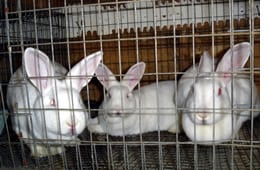 Obviously, larger animals produce more meat per head, but this could be a liability under the wrong circumstances. For instance, when we butcher a hog, we get anywhere from 75 to 130 lbs. of meat. Most, if not all, goes directly into the freezer. That’s a considerable investment on ice, and if there were a grid failure as a result of a simple temporary power outage, a freezer full of meat would quickly become worthless. Even worse, if the outage were a result of a major economic dislocation, there goes all that effort down the drain just when it is needed most. Plus, it’s a helluva lot more work to raise and process a large animal.
Obviously, larger animals produce more meat per head, but this could be a liability under the wrong circumstances. For instance, when we butcher a hog, we get anywhere from 75 to 130 lbs. of meat. Most, if not all, goes directly into the freezer. That’s a considerable investment on ice, and if there were a grid failure as a result of a simple temporary power outage, a freezer full of meat would quickly become worthless. Even worse, if the outage were a result of a major economic dislocation, there goes all that effort down the drain just when it is needed most. Plus, it’s a helluva lot more work to raise and process a large animal.
Smaller, or micro-animals, on the other hand, yield a family-size meal (with a little left over for the dog). They’re always fresh until needed and are easier on my old bones to process. It hasn’t escaped me that my chickens deliver the same advantage and give me eggs to boot, thereby possibly rendering rabbit-keeping superfluous. The rabbit, however, has some qualities that make it worthy of serious consideration:
- Reproducibility: Rabbits are legendary reproducers; chickens, not so much. Unless one is fortunate enough to have a hen or two go broody, there is no other option than to buy chicks from an outside source, which reduces sustainability and increases cost. The only other option would be to incubate your eggs, which is more meticulous than rabbit breeding.
- Ease of butchering: De-feathering is a far more tedious task than skinning rabbits. It also takes a minimum number of chickens to justify the fuel expense of heating water for the process. Butchering a rabbit can be done singly or in whatever quantity is convenient with a bare minimum of facilities.
- Feeding: Although commercial feeds for both types of animals are available and equally convenient, chicken rations are composed mostly of grain. Aside from the recent trend away from grain fed meats and toward grass fed because of Omega 3 issues (Paleo diets), grains are not as readily procurable locally as the typical plant components that comprise rabbits’ diet. While not a major factor, this does affect resiliency.
- Small Space Requirements: Rabbits take in stride the small cages that are unsuitable for chickens, allowing them to be kept even in the tightest of quarters, which is great for urban settings. Chickens, on the other hand, require a considerable amount of space.
- Good Neighbors: Because they are quiet, clean, and mostly viewed as pets, rabbits are accepted in even the most stringent HOA (homeowners' association), whereas chickens are usually disallowed. Your neighbors most likely won’t even know they are there.
Which Breed?
Although any breed of rabbit is tasty, there is a significant difference to consider when choosing a breed. There are dwarf rabbits as well as very large breeds like the 20 lb. Flemish Giant, which could be tempting if size were the only consideration. But, again, bigger is not always better, for although the giant breeds offer a larger carcass, they are not the most efficient at converting feed into meat, and neither are the small breeds. That award goes to the medium breeds, the most popular being the Californian and the familiar New Zealand, which is commonly recognized by its snow-white fur and red eyes. At a ratio of around 3.5:1 (pounds of feed required to yield a pound of meat), these particular breeds nearly equal the feed conversion ratio of the animal kingdom’s conversion champion: the factory-farm raised Cornish Cross chicken at 2:1. Most larger animals are in the 5:1 ratio or higher. While there are many other factors to consider that may lead to a different selection, my purpose is solely to procure meat, so to capitalize on this efficiency feature, I went with the New Zealand rabbits.
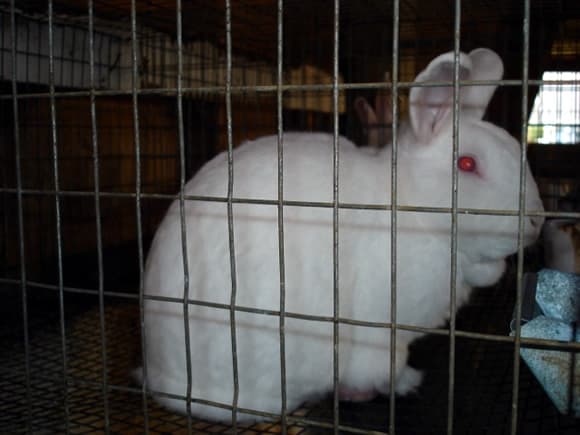
New Zealand buck
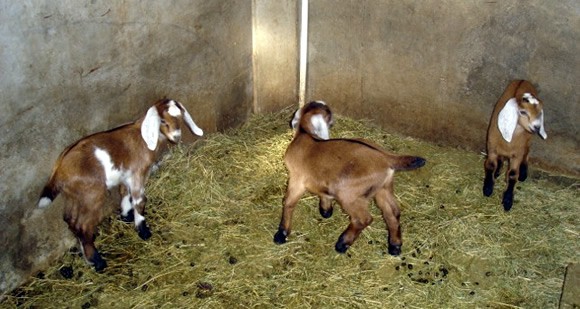
Yeah, I know, those aren’t rabbits. They’re the rabbits’ next door neighbors: 4-day-old Nubian goats. I was standing there with a camera and just couldn’t resist.
Home Sweet Home
The easiest, most economical and effective way to house rabbits is in a cage constructed of 1”x2” welded wire for the top and sides, with smaller mesh ½” x1” welded wire for the bottom. All cage-making supplies, like these wire clamps and clinchers, can be found at Strombergs.
A small cage of about 30 inches by 30 inches square at 14 inches high enables even an apartment dweller to raise a rabbit or two and puts rabbit keeping within reach of the urban prepper with a limited amount of space. The objections some (most?) have to caging chickens in such a small space don’t really apply to rabbits, as it doesn’t seem to bother them. I once had to put a rooster in one of my rabbit cages for a couple of weeks and he paced constantly and picked at his feathers, whereas rabbits lay around and sleep all day, only occasionally getting up to stretch and yawn on their way to the feed trough.
I think hanging the cages is far and away the best way to go, especially if space is at a premium. Two tiers of cages could be hung in a six foot vertical space (two fourteen-inch cages, with an eighteen-inch vertical separation between cages to accommodate a slanted tray to deflect the manure from the upper cage, and an eighteen-inch clearance from the floor). The cages can be hung in a garage, shed, patio, or just about any place you can think of with overhead and wind protection. This horse stall now houses my rabbits, their food stockpile, and the chicken food stockpile.
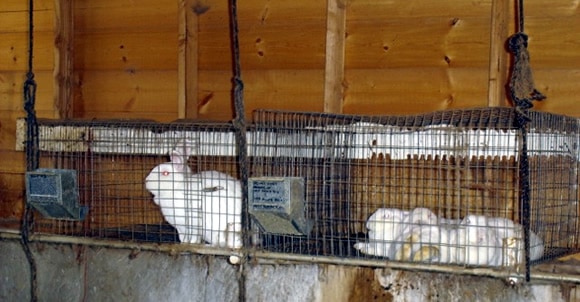
Cages are hung on hooks along back wall and piece of 1/2" metal electrical conduit along front.
Just be sure to protect them from the heat. Rabbits can endure cold better than they can endure heat. Even if you build a traditional-style wooden hutch with a roof, be sure to account for heat radiating through the roof. A low roof in hot sun can kill a rabbit. Build a much taller hutch or put it in the shade. Also, provide a minimum of 18” clearance from the ground to facilitate sanitation and reduce parasites. A while back, my chickens, (who used to roam the place but now reside in chicken tractors), became infested with sticktight fleas (Echidnophaga Gallinacea), which eventually infested the rabbits whose cages at that time were on blocks. Nasty. I was reluctant to use an insecticide; I then learned from this article that the fleas lay their eggs in the dirt and that the larvae can only jump 18”. I raised the cages to 18”, thus breaking the breeding cycle of the fleas, and all signs of infestation disappeared after about two weeks.
An automatic watering system for your rabbitry is essential. Refilling water crocks was, at one point, by far the most labor intensive part of caring for my rabbits, and it eventually forced me to come up with a better solution. Stromberg's automatic watering systems with Edstrom waterers caught my interest, but the cheapskate in me deemed it to pricey (around $200). So I devised my own system for about $30 total. Mounting this float valve from a horse waterer inside of a 10” long piece of 4” PVC drain pipe with a cap on each end formed an automatically refilling tank.
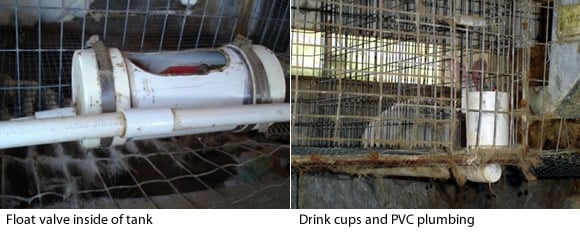
A 1½” PVC coupling with a ½” reducing bushing serves as the drinking cup. Tank and drinkers are connected by ½” PVC pipe. Since this system is connected to the domestic water supply, it can effortlessly accommodate dozens of cages with the following caveat: Because the water is gravity fed to each cage, all drinking cups must be at the same level as the tank, or else the lowest in the line will dribble and any above the tank will be dry. As a refinement, I will soon be changing out the drinking cups by replacing them with Edstrom valves like this one rigged up on my chicken tractor:
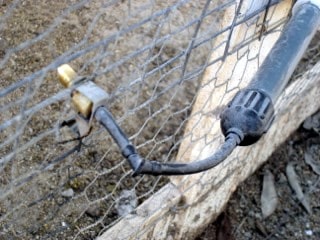
Edstrom drinking valve connected with drip tubing and PVC.
The valves are cheaper by the dozen and provide the advantages of allowing for mounting without any height/level issues, thus allowing the same system to accommodate multiple rows of cages and eliminating the occasional task of cleaning the drinking cups. I’ll mount the float valve inside a food-safe 5-gallon bucket; much easier to make than the PVC drain pipe arrangement and cheaper than the options from Stromberg’s.
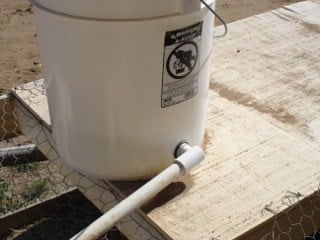
Figure 7 Bucket tank
These feeders are basic and are all you’ll need. There are different options, like a screened bottom (my preference) that allows the powder from the feed to fall through, as well as different sizes. The lid version might come in handy, but I couldn’t see the need so I have never tried one. They also have a slot to hang index cards for record keeping (see below). Feeding time is quick and easy: I simply walk down the row and scoop the portions into the feeders, twice a day. It takes less than thirty seconds for all seven cages.
Feeding
One of the key features that I found most reassuring about rabbits as a piece in the resiliency puzzle was the ability to safely and easily store a very long-term supply of commercial rations. These rations come in the form of a small green pellet, probably familiar to most everybody, and provide all the nutrition a rabbit will ever need. If you fed them nothing else, that would be okay. Unlike stockpiling human food into buckets with Mylar bags and oxygen absorbers, it seemed far more practical to store rabbit food that, when combined with a few small critters in small cages, would provide a superior food source. I bought a ton (literally--- forty 50-lb. bags on a pallet) of feed and stored it in 55-gallon drums and trash cans. This has lasted me for over three years and more than two dozen litters of very tasty rabbits, with about 250 lbs. of feed still remaining.
I have begun restocking, but I am now looking for feed supplements and substitutes than I can grow on site myself so as to reduce or maybe even eliminate outside inputs of resources, thereby improving sustainability and extending the lifespan of my rabbit food flush as well as greatly reducing costs. Some of the possibilities are roughages like hay (alfalfa, oat, timothy, etc.), grasses, garden greens, concentrates like grains, bread, milk (yes, milk!), sunflowers, comfrey, beets, lettuce, spinach, or really just about anything that you would grow for yourself. Even many weeds that grow in your garden will be appreciated by your bunnies. Oh, yes, don’t forget carrots! Just be sure that the overall diet has sufficient protein, and be careful of giving too many succulent greens to young bunnies-they are prone to diarrhea.
Breeding
The legendary breeding abilities of rabbits make it quite simple to propagate them. Simply put the female (doe) in the buck’s cage (not vice versa, as they will fight as she defends her space) and walk away. Or you can watch, if you have nothing else to do. Immediately he will begin to chase her around the cage. If she’s receptive, she will stop; if not, he will catch her eventually. Either way, it’ll be over within a few minutes. A successful mating is indicated by the male falling off of her onto his side, sometimes with a squeal. (Don’t try this at home, fellas!) Even if I witness a successful mating or two (the buck will be ready again after a couple of minutes), I usually leave the doe in with him for a day or two, just to be sure, before returning her to her cage. The doe will kindle (give birth) about thirty-one days later. About three days before that happens, you will need to put a nest box in her cage with some wood shavings (not sawdust; it’s too fine). My nest boxes were made from OSB, but I think plywood would have been better. They measure 9” high and wide by 12” long. The doe will then pull fur out of her body and make a nest in the box.
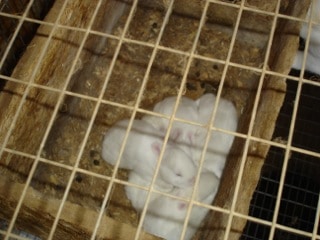
Nest box viewed from above with five 2-week old babies.
Litters can be as few as one bunny or more than ten, although the largest I’ve had is eight, with the average about five or so. The youngsters are weaned by six weeks, and by three months are ready for the dinner table! Think about that: Four months from mate to plate.
Let’s do some math. While commercial breeders want at least four or five litters per doe per year, a more reasonable number is three litters per year. With five does and an average of five per litter, that’s seventy five rabbit dinners per year or one every five days. Compare that with larger animals, say hogs, which require five months gestation and another eight to grow out to eatin’ weight. That’s thirteen months from mate to plate, at which time I’ll have anywhere from a half dozen to a dozen hogs ready to slaughter from one sow. If I slaughter one, and net 90 lbs. of meat, not only do I have all that meat to preserve, but I still have the rest of the litter to feed until their moment comes. That’s thirteen months of paucity and then an overabundance that presents a logistical problem. By rotating rabbit breeding, a slow steady supply of fresh meat can be achieved with a minimum of effort. Also, since rabbits are sexually mature at three months, production could be quickly ramped up by reserving some promising young does for breeding rather than slaughter.
Record Keeping
I’ve found that record-keeping is beneficial for even the smallest of farming operations and mandatory for anything larger. With five breeding does and two bucks, it’s essential that I know when a certain doe was bred, and to which buck. Without a log, it’s easy to forget when a doe’s due date is and thus when to put in the nest box. Also, by recording the results of each pairing, one can determine which does are more productive (i.e., how many are in each litter) and equally important, how good a mother they are. Sometimes does will not make a nest and may even kindle outside of the nest box.
I have a doe who once made no nest and kindled out of the nest box, which resulted in the total loss of the litter, only to have her make a nest the next day after it was too late. (If she does it again, she’s toast; or more accurately, fricassee.) Others will occasionally do everything right with regard to nest building and then proceed to neglect the young. Good records will reveal any patterns, affording the opportunity to cull out any poor performers. The feeders have a slot for index cards on which can be recorded some useful info, but I’ve found that a farm journal in a notebook is much more comprehensive.
The Grim Reaper
Please be advised that the following may not be pleasant reading for the squeamish. Also note that, although it may seem from this write-up that I approach this task casually, it still gives me pause. Even though I’ve slaughtered many more rabbits than goats, sheep, or pigs, I still wince every time I have to do the deed. It’s much more personal because it’s one thing to shoot an animal a few feet away but quite another to hold it in your hands to dispatch it. For some reason it makes a difference. Click to read more.
Again, the small size of rabbits makes the task much easier. Butchering a rabbit is pretty light work compared to the larger animals, and as you will see, it only requires the minimum of implements, but a very sharp knife is essential. Placing the animal on the table in front of me with his head to my right and hindquarters to the left, I pick him up by the back legs with my left hand and after a moment or two of kicking (and sometimes squealing) he will stop, at which time I use a 18” length of ¾” iron pipe (or a hammer, club etc.) to strike sharply on the back of the head behind the ears. This is not the time to grow faint of heart. If he’s going to be struck, then strike hard enough to instantly render him unconscious; misplaced mercy at this moment only makes it worse.
I slip the rear legs into the loops of my hanger (see photo below) and tighten, then quickly cut off the head, allowing the blood to drain into a 5-gallon bucket (I save the blood for the garden by putting a little water in the bucket so it won’t congeal or stick to the sides of the bucket).
Cut off the front paws by cutting an incision through the fur around the “forearm” and then striking the bone crisply with the back of the knife. Cut any remaining tissue and the front paw is free. Repeat for the other paw. Move to the back end by cutting off the tail as close to the body as you can, then cut the fur around the rear leg just above the “ankle,” being careful not to cut the tendon running up the back of the leg. If you cut this tendon, there is the possibility that the back leg(s) will tear apart when you go to pull the skin off. I have found that rather than risk cutting this tendon by just running the knife around the leg as you would for the foreleg, it’s better to take a pinch of fur/skin with the left hand and pull it away from the leg and then cut it away piece by piece around the rear legs as well as the genital area. Then, slip the knife point under the skin through any hole made by cutting away the tail, genitals, or around the legs, and cut to connect all the incisions, but without cutting into the body cavity. The back of the knife should be against the body, with the sharp edge cutting outward.
Once the back legs, tail, and genitals are free, the pelt can be pulled down over the body like a sock being turned inside out. It might hang up a little at the neck and front legs, and some pelts pull off more easily than others. Just keep tugging and it will come free. Slit the membrane that covers the abdomen from the groin to the breast by inserting the knife with the sharp edge again cutting outward. I insert two fingers on one hand into the body cavity with the knife between my fingers in order to guide the knife so as to avoid puncturing any organs, which would spill out their contents. Once the membrane is cut, the viscera can be scooped out. You will note large strips of fat deposits on the inside of the body cavity and along the back.
Rabbits don’t have fat marbling in the meat like other animals; it’s concentrated in these deposits, as shown in some of the photos. The result is a very lean meat. The chest cavity that contains the heart and lungs is separated from the intestinal area by a diaphragm. The breast bone can be cut with the knife, allowing access to the chest cavity. Clean it out in a similar fashion, then insert the knife down through the empty chest cavity and out through the neck, cutting so as to open up the throat area to be cleaned. Do the same at the other end by inserting the knife upward from the abdominal cavity through the anal vent and lifting the handle as you go. Using a prying action, the knife should easily cut through the pelvic bones, allowing access to this area too.
Once the body is opened from stem to stern, wash it thoroughly by rinsing in cold water. The carcass can be cut up into pieces or used whole. Because I usually process at least five or six at a time, I like to ice them down before I vacuum seal and then freeze them. Altogether, it takes me, working alone, about ten minutes to process each rabbit, or about an hour and a half to two hours to process half a dozen, including prep time and clean-up.
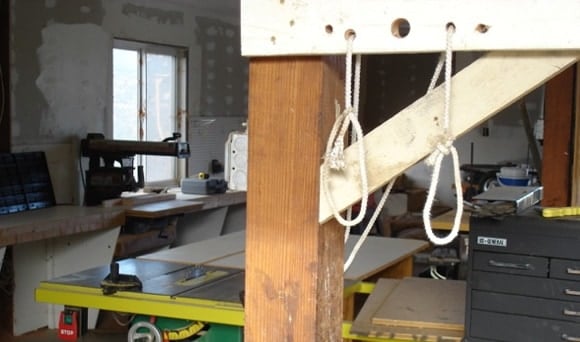
Figure 9 Hanger
One piece of hardware that I rigged up is the hanger with a rope noose arrangement for the hind legs. Most common is to hang the carcass by hooks or large nails through the space between the two bones in the lower rear legs. What I discovered is that the subsequent cutting and pulling during the process would sometimes cause the hooks to tear out the tissue and the carcass to fall off. By suspending it from ropes looped just above the rear foot, it is now more secure, making it possible to apply much greater force when pulling the hide down over the head.
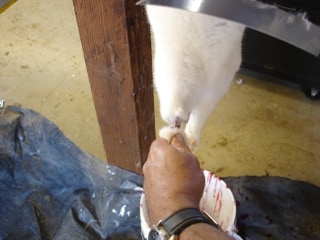
Cut around front leg and strike with back of knife
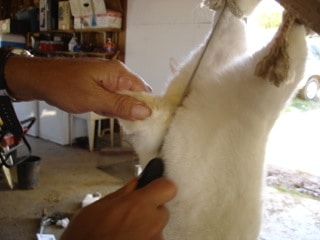
Cut off tail.
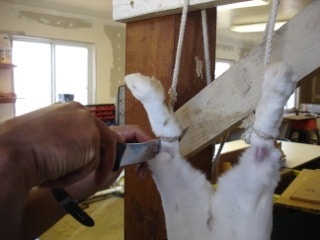
Cutting around rear leg.
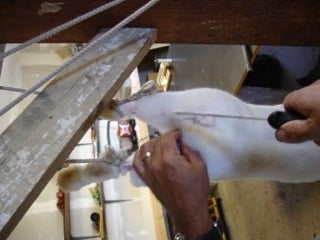
Connect cuts on back end.
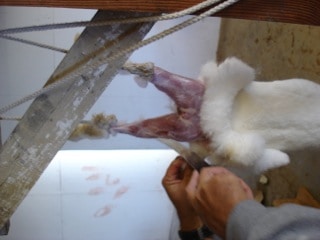
Use knife as necessary to free pelt from back end.
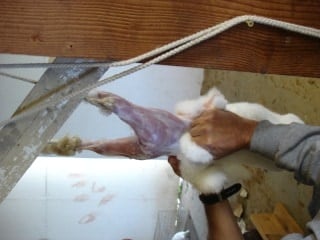
Pulling down the pelt like pulling off a sock.
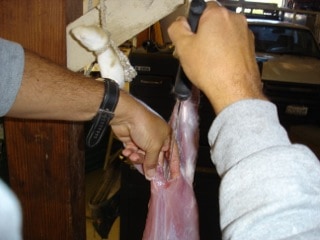
Slitting open abdominal cavity.
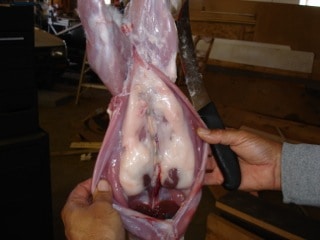
Abdominal cavity empty; note kidneys nestled in strips of stored fat.
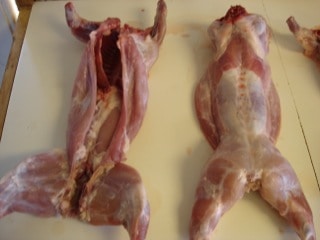
Finished product.
Tastes like chicken
Rabbits can be cooked just about any way that a chicken can, although the first and only time I tried frying a rabbit, the results were just a little disappointing: Although the flavor was good, the texture was kind of rubbery. I subsequently learned that this was caused by cooking at a too low temperature. I’ve had very good results on a rotisserie and baked, but my favorite is using the Crock Pot, experimenting with various sauces and marinades. One thing to consider is that the rabbit has very little body fat, so the meat is extremely lean. You’re definitely going to want to cook ‘em with additional oils and fat or the meat might be too dry. Also be aware that rabbits have some really small bones, particularly the ribcage. This seems to require extra care only after the meat falls apart in the Crock Pot.
Miscellaneous
To get the most bang for the buck, I try not to let anything go to waste. As previously noted, I save the blood for fertilizing, but I also serve up most of the organs for dog food, and rabbit manure is very highly regarded as a fertilizer. I even save the furs for some future as-yet-to-be-determined tanning project by vacuum sealing and freezing them. I’m not sure what for (any suggestions?) but I just couldn’t throw them away; they come off the carcass so clean, white and soft, they’ve got to be good for something useful.
In Closing
When I look around at all the livestock that I’ve have, I sometimes wonder if I’ve gone a little overboard with it all. Then I look at my feed bill and know for sure that I have. In those moments when I wonder which animals I could do without, I’ve never even considered eliminating the rabbits from my game plan; it’s non-negotiable.
While I’m not of the opinion that we will see a chaotic crashing of the economy, the odds of it happening are a little higher than I’m willing to bet our survival on, and it’s Mr. Bunny that I consider my ‘go-to guy’; it costs very little to keep him on in the bullpen. But more than that, I think it’s because rabbits are the most easy and ‘easy-going’ of all. From the small space requirements, the cheap and easy cages, the ease of storing food, the ability to butcher with merely three utensils (club, knife, hanger), the efficiency of feed conversion, to the convenience of one rabbit yielding one family meal, they provide the best return on my sweat equity investment.
This What Should I Do? blog series is intended to surface knowledge and perspective useful to preparing for a future defined by Peak Oil. The content is written by PeakProsperity.com readers and is based in their own experiences in putting into practice many of the ideas exchanged on this site. If there are topics you'd like to see featured here, or if you have interest in contributing a post in a relevant area of your expertise, please indicate so in our What Should I Do? series feedback forum.
This is a companion discussion topic for the original entry at https://peakprosperity.com/resiliency-with-rabbits-2/